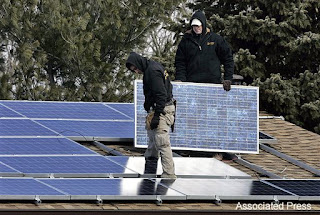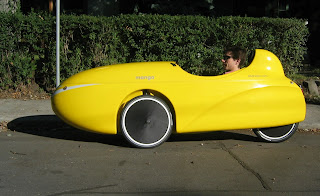Monday, June 23, 2008 by Kyle Scribner
 Having a few potted plants spread around the workspace is a time-honored way to lend vibrancy and character to an area that, let’s face it, can be downright drab. The benefits of having greenery around the office are many, including increased job satisfaction, surveys have shown. But with the explosion of the green movement, enthusiasts are going far beyond simply hanging a few spider plants. Rooftop gardens are sprouting on homes and offices around the country, illustrating what can be done with tiny spaces and resources – conditions you often see in the city. You don’t have to take it as far the Dervaes family of Pasadena, Calif., (but if we all did we probably wouldn’t be worrying about salmonella tomatoes or the price of gas), but Green Among Gray would like to see what kind of greenery Captivate viewers have blossoming around the office. Got some cubicle Chrysanthemums or corner-office Crocuses? Show us by submitting photos to kscribner@captivate.com and your pics may wind up on Captivate Network. Labels: green, office plants, rooftop garden, work
  |
» |
»
Wednesday, June 18, 2008 by Kyle Scribner
 Ah, our government. One minute, it’s a shining example to all the free world. The next, it’s a model of contradiction and inefficiency. Exhibit A is the current stalemate in Congress over extending tax incentives for renewable energy. It’s a no-brainer. No matter how you feel about global warming or the oil industry or the environmental movement, it’s understood our main energy resources are finite and will eventually be exhausted (though the timing of such “peak oil”-type scenarios is still being debated). We must pursue alternatives. The government is pretty much united on at least that much. But, of course, a problem arises with financing. Dems and Republicans are battling on how to pay for solar and wind incentives, as detailed in this San Francisco Chronicle article. The incentives are in danger of not getting extended, which would almost assuredly put a halt to thousands of alternative-energy projects around the country, such as San Francisco’s plan for the nation’s largest municipal solar incentive program. For a look at one of the government’s own projects to encourage the development of sustainable energy, check out the Department of Energy’s Solar America Cities. Ten Captivate Network markets are among the 25 cities taking part in this program to “encourage adoption of solar energy technologies at the local level.”
Let us know what you’re thinking by posting a comment below. Are you considering any solar projects on your home?
Labels: peak oil, renewable, solar, Solar America Cities, Wind
  |
» |
»
Monday, June 16, 2008 by Kyle Scribner
 There are always a couple ways we can look at things. You know, glass half-full or half-empty. An optimist, for example, might look at high gas prices as an opportunity to get more exercise. The pessimist lets the prospect of sustained $5-a-gallon gas fuel his road rage. An optimistic Celtics fan thinks, “Cool, we get to win it at home.” A pessimist thinks Kobe looks strong, Garnett is tired, and the Lakers have a chance to actually win two in Boston. And so it is with the environment. The Washington Post reports that up to 2 million acres of wilderness will be added to federal protection this year, which equals the total set aside over the last 5 years. “Fantastic!” some of us think. “That’s real progress.” But others will focus on the fact that the U.S. loses four acres of open space per minute and think, “2 million acres is not enough.” If you’re one of the ones that don’t think it’s enough, you can join the conservation push at the Wilderness Society, which is matching donations right now. Optimist or pessimist, let us know where you come down by posting a comment below.
Labels: congress, conservation, open space, wilderness
  |
» |
»
Wednesday, June 11, 2008 by Kyle Scribner
 There are times when life feels like a bad movie. I filled up my little Mazda Protege today, watching in horror as the meter zipped past $20, then $30, and into the uncharted $40 territory. “Press YES for receipt,” the monitor flashed, as though mocking my disbelief by offering hard-copy proof. I felt like I was in some dystopian Road Warrior ripoff. But it’s real. And it will get worse. The U.S. Energy Information Administration said it expects the price of a gallon of gas to peak at $4.15 in August and to average $3.78 for the year. So Green Among Gray would like to know what people are doing to combat this. Are you carpooling, working from home more often, riding a bike, buying a hybrid? For just one example of how to beat the system, Captivate Network’s own Michal Kapral (above) gets around his hometown of Toronto in his pedal-powered, eye-catching velomobile. Let us know what you’re doing to save money and the environment. Leave a comment, and your response may run on Captivate Network
Labels: carpool, gas prices, hybrid, telecommute, velomobile
  |
» |
»
Monday, June 9, 2008 by Kyle Scribner
 The Warner-Lieberman bill was stymied in the Senate, putting the brakes on the nation’s most immediately viable option for controlling greenhouse-gas emissions. Assuming something does indeed need to be done (there are still quite a few out there who tend to think the whole human-caused global warming thing is a sham, or at least too poorly understood to call fact), we’re going to take a look over the coming weeks at various solutions being offered by some of the best minds on the subject. Today we’ll look at Dr. James Hansen’s latest recommendation. Hansen (above), a prominent NASA scientist, is often the target of environmental skeptics for his outspoken views on the pressing need to take action against climate change. He proposes a system in which the biggest greenhouse gas emitters would be taxed, with 100% of the tax money given directly to Americans to offset any energy rate hikes. Dr. Hansen lays out his “tax and dividend” plan here (pdf). What do you think – would the plan work? Labels: climate, Dr. James Hansen, NASA, tax and dividend, Warner-Lieberman
  |
» |
»
Thursday, June 5, 2008 by Kyle Scribner
 Green Among Gray’s entire premise is faulty. Yep, turns out my whole “just because you live in a big city doesn’t mean you can’t be green” angle is invalid, according to this Brookings Institution study that found people who live in major metro areas actually have smaller carbon footprints than those in more rural areas. Who’da thunk? But don’t fret dear Green Among Gray enthusiast (after 8 weeks there must be at least one of you out there, right? Hello?); even though this study calls into question the core of my mission, I’m not shaken. There are too many things still to learn. And you know what? I’m magnanimous enough that I’ll take a lesson or two from this very study. Its seemingly counterintuitive conclusion – that the average resident in the 100 largest U.S. metropolitan areas has a smaller carbon footprint than the average American overall – is actually not so surprising when you consider:
- Mass transit: Available only in big cities. The American Public Transportation Association says mass transit reduces the nation’s carbon emissions by 37 million metric tons annually.
- Public awareness: Many of the lower-footprint cities on the Brookings list are in Calif., where awareness of climate-change issues is high and aggressive green legislation is widespread. It seems reasonable to assume this urban concentration of awareness extends, in a general way, throughout the country.
The study says the average resident in the biggest 100 metro areas emitted 2.24 tons of carbon from highway transportation and residential energy in 2005, compared with 2.6 tons of carbon emitted by the average American. To bring it home for Captivate Network viewers: Six of the 10 lowest-emitting areas on the Brookings list are Captivate markets (L.A., NYC, Seattle, San Jose, San Fran and San Diego), while there are no Captivate markets among the 10 metro areas with the largest carbon footprints. But urbanites shouldn’t be tooting their horns (or yanking their stop indicators, as it were) too much; there’s still plenty of room for reduction. So, city dwellers, let us know what actions you’re taking to lighten that footprint. Labels: Brookings Institution, carbon footprint, CO2, mass transit, metropolitan
  |
» |
»
Monday, June 2, 2008 by Kyle Scribner
CFLs may be the best energy-efficient lighting solution now. But there are drawbacks, from the bulbs’ use of mercury to their light-up lag time. So what’s the future of low-energy lighting? The U.S. Department of Energy thinks it may be solid-state lighting. Solid-state uses semiconductors, instead of filaments (as with incandescent bulbs) or gas (as with fluorescent), to create light. The result is a light-emitting diode, or LED (Rensselaer Polytechnic Institute has plenty on the science behind just how this happens). LEDs aren’t just for calculators and watches anymore. They’re now used in applications such as traffic lights and under-cabinet lighting. But the Dept. of Energy sees a day when most regular home lighting will be LED and has announced a $20 million contest to usher in the household solid-state age. The DOE predicts the development of an LED that will use just 10 watts to produce the same light a 60-watt incandescent bulb does – higher efficiency than a CFL, among other advantages. Tell us what you think – how could LEDs change your cubicle world? Labels: DOE, LED, RPI, solid-state lighting
  |
» |
»
|

Kyle Scribner is a born-again nature freak who also happens to be an editor at Captivate Network. You know that exhilarated feeling you got as a kid when you would go down to the pond to catch frogs? It never really goes away; it’s just dormant. So I'm here to slap a mix of facts and borderline balanced opinion on you, to poke a stick at the nature freak slumbering in us all and maybe get him to once again come out and play. And we might even learn a few things about the environment as we go.
About Green Among Gray
How do you commune with nature or become part of the solution to the environmental crisis when you're trapped in a cement-and-glass, gas-guzzling, power-sucking, emissions-spewing metropolis 8 hours (or more) a day? How do you go 'green' in a world of gray?
Actually, there are plenty of ways, and Green Among Gray aims to show high-rise inhabitants how they can help ease the load on the environment and on their minds by exploring natural oases, conservation tips, and other ways to stay green while working in the concrete-built world of the big city.
Look for short updates on the latest environmental news along with periodic longer features on specific places and events that allow big-city workers to get close to nature.
|







 Kyle Scribner is a born-again nature freak who also happens to be an editor at Captivate Network.
Kyle Scribner is a born-again nature freak who also happens to be an editor at Captivate Network. 